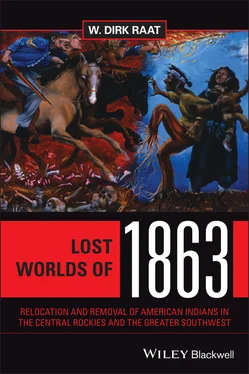1 ...8 9 10 12 13 14 ...29 As these expeditions moved from coast to mainland, the activity of slave hunting was transformed from the Italian compañía to the Iberian reconquest tradition of compaña or band of men (sometimes called “soldiers”). 13The leader(s) and ordinary men would finance the entire expedition and be whole or partial shareholders, with each man receiving a share of the booty (slaves, gold, encomiendas , etc.) based on the size of their share and their importance for the mission. For example, a powerful leader might receive several shares, while a horseman would only get one share and a foot soldier a half share. Many of these conquerors had personal servants, often Indians, whose skills, including slave hunting, were in high demand. These auxiliaries were known as naborías and were also a prelude to the history of slavery and the slave trade in Sonora and New Mexico. 14It was a blending of these Italian and Spanish heritages that was used to conquer the Greater American Southwest.
The most common arrangement between conquered and conquerors in the sixteenth century was known as the encomienda . The first conquerors who received a royal grant of encomienda to the labor and tribute of the conquered Indians were known as encomenderos . Encomienda Indians were not technically slaves since they lived in their own villages or sedentary communities. They could not be sold as individuals or separated from their own ethnic group to live under direct European influence. Yet, in the early sixteenth century, as a group they owed the encomendero both personal service and tribute. The encomienda also furnished Spanish men with Indian concubines. Although the New Laws of 1542 tried to limit the encomienda to tribute only, outlawed Indian slavery, and guaranteed the ecomienda’s existence for the life of its present holder and one successor, the encomienda (usually as a subterfuge for slavery) continued to exist well into the eighteenth century in the frontier areas of Venezuela, Chile, Paraguay, the Mexican Yucatan, and the Spanish borderlands of the Greater American Southwest. And even though the Spanish state had a stake in curtailing the owning of slaves by colonists, cannibals (such as the Caribs of the West Indies) or rebellious Indians (e.g., the Chichimeca [Apaches] of northern Mexico) could be enslaved, the latter by military personnel in the presidios. 15The institution of the encomienda was one of the major grievances that led the Indians to rebel in the Pueblo Revolt of 1680 in New Mexico and Arizona. 16
As the Indian population declined and the price of labor increased, the state moved to reduce the number of encomenderos and colonists who had access to Indian labor and preserve ever scarce Indian labor for state and public projects. The name for this institution was taken from the earlier period when a share was an allocation or repartimiento . The repartimiento was in full force in central Mexico from about 1560 to 1620, while it continued to exist in Peru (known there as the mita ) until the end of the colonial period. Under the repartimiento Indian laborers worked in the silver mines, built forts, roads, and buildings for the army and government, and did agricultural work and construction for the Church. Again, like the encomienda, repartimiento continued to exist in frontier areas of Mexico, especially around missions and presidios in northern Mexico and the borderlands, including Florida. Although repartimiento laborers were supposed to be paid a minimal wage, and their working hours were limited, institutional means of enforcement were weak and temporary workers were often unsatisfactory laborers. Thus the colonists tended to replace them with contract workers or personal servants and/or slaves. 17
Because the institution of Indian slavery on the frontier continued in one form or another after the New Laws of 1542, the government made a continued effort to outlaw the enslavement of Indians. This was partly simply a struggle between the royal bureaucracy and the colonists over control of Indian labor, but it was also the position of the Church based on Christian principles. In spite of a history of legislation opposing slavery, the institution persisted in the frontier zone beyond 1800 and the colonial era.
In 1769 an emancipation proclamation was issued by the Spanish Governor of Louisiana, Alejandro “Bloody” O’Reilly, stating that all Indian slaves were to be freed upon the death of their masters, and babies of slaves were to be free at birth. That next year Spanish St. Louis, according to census data, reported that 66 Indian slaves were being held in that city, mostly women and children. Obviously, the King’s law stopped at the gates of the city, with all the area claimed by Spain from the Mississippi to the Rocky Mountains being untouched by the Spanish edict. 18
On September 15, 1829, President Vicente Guerrero emancipated all slaves in Mexico. A law in April 1830, prohibited the introduction of slaves into Spanish Texas. Needless to say, Mexican frontiersmen in Coahuila, and Tejanos (Mexicans in Texas) and Anglo-Americans in Texas protested these laws and did their best to evade the law’s intentions. 19The law was not enforced in Texas. As mentioned before (see endnote 9), 25% of the population of Texas prior to 1836 consisted of African slaves.
Although slavery had been legally abolished in New Mexico while a province of Mexico, in actuality, slavery still persisted after 1850 when New Mexico acquired US territorial status. In 1858, a proslavery faction of the territory passed a slave code known as the Otero Slave Code (named for Miguel Antonio Otero, a delegate in Congress from New Mexico), and approved by Governor Abraham Rencher on February 3, 1859. This slave code was similar to those of the southern confederate states, including provisions requiring runaway servants to be arrested, fines and punishments for slaves violating curfews, and imprisonment for any person found guilty of giving a slave a sword or any firearm. This slave code specifically affirmed “that it in no way applied to peonage and that the word ‘slave’ designated only a member of the African race.” 20
When, in 1860, the New Mexico legislature attempted to extend the Otero Code to male and female Indians, the governor vetoed the bill. The governor explained his action by saying: “The act apparently is founded on the supposition that the Indians acquired from the savage tribes were slaves; which is not the case; neither is it in the power of the legislature to make them such … . The normal or native condition of our Indian tribes is that of freedom and by our laws they cannot be made slaves either by conquest or purchase. We may hold them as captives or peons but not as slaves.” 21The governor, like most New Mexican citizens who held peons and captives, was in denial that their form of peonage or “enforced servitude of savages” was not a form of slavery. Only African slavery deserved that epitaph.
Indian slavery in New Mexico, intertwined as it was with peonage and kinship, took several decades to die. One example of this would be the ineffectiveness of President Andrew Johnson’s directive of June 1865 declaring that slavery in the territory of New Mexico was in violation of “the rights of Indians” and instructing his subordinates to participate in “an effective suppression of the practice.” 22The president’s letter elicited a response from Felipe Delgado, New Mexico’s Superintendent of Indian Affairs. To Commissioner of Indian Affairs, William Dole, he argued that:
It is true that there are among the citizens of this country a large number of Indian captives … but the object in purchasing them has not been to reduce them to slavery, but rather from a Christian piety on the part of the whites to obtain them in order to instruct and educate them in Civilization. … This has been the practice in this country for the last century and a half and the result arising from it has been to the captives, favorable, humane, and satisfactory. 23
Читать дальше












